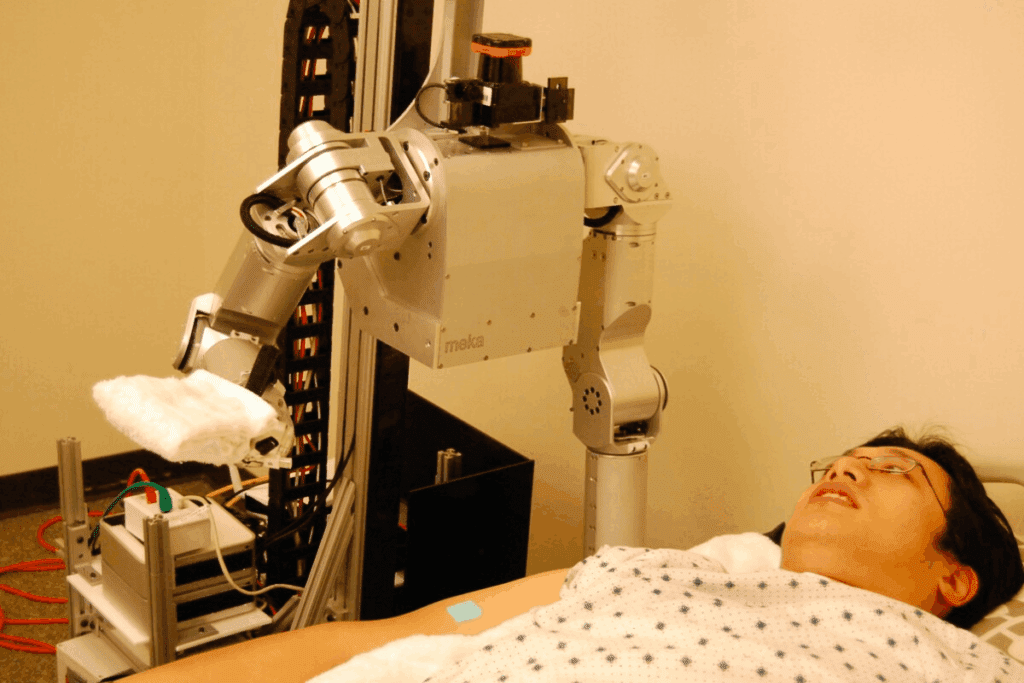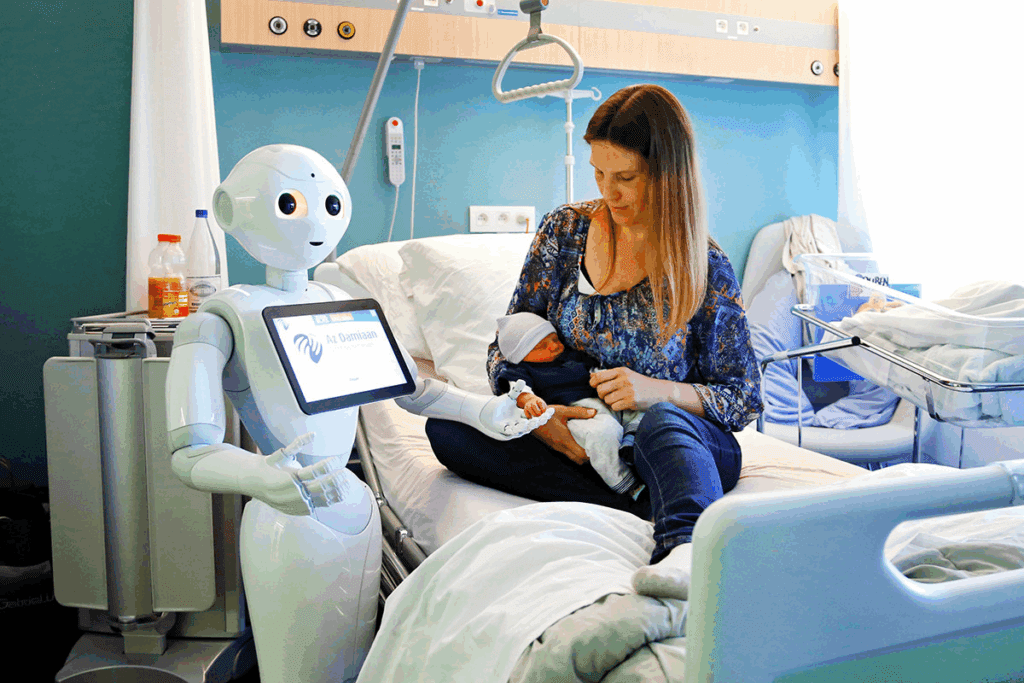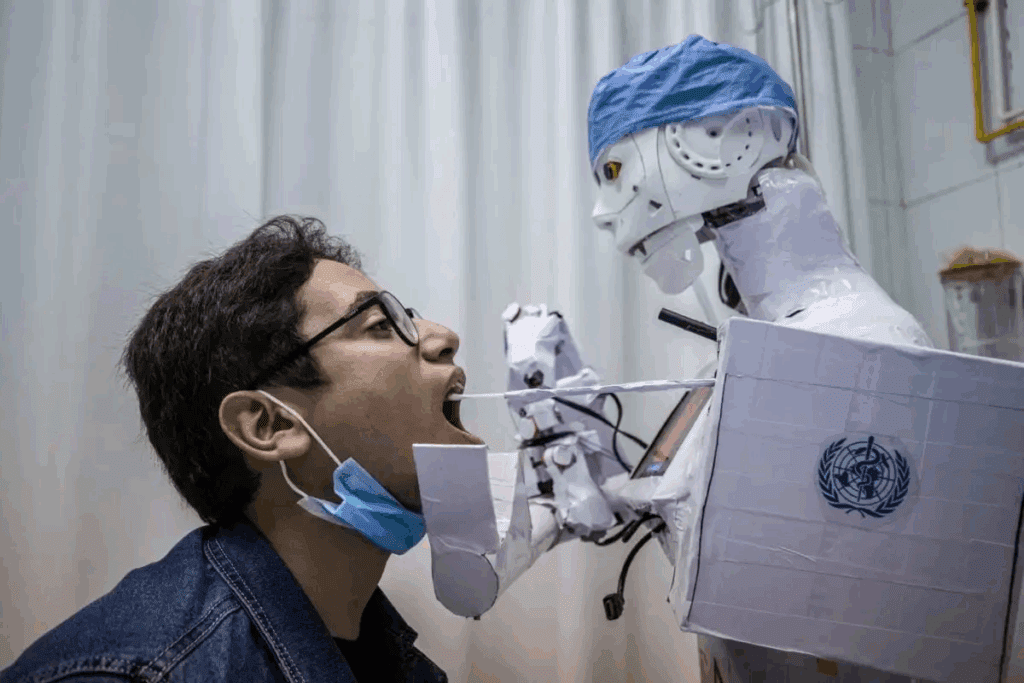Last Updated on November 27, 2025 by Bilal Hasdemir

As humanoid robots and android robots become more common, they’re changing many fields.
Robots in Real Life help with tough tasks as well as simpler ones, offering wide and varied uses. However, as their adoption increases, challenges in manufacturing and practical implementation continue to grow.
Robotics has grown from a dream to a real part of our lives. It has changed many industries and how we work and live.
Robotics moved from science fiction to real life. Big steps in AI, machine learning, and engineering made this happen. Now, robots can do complex tasks, talk to us, and change when needed.
Robotics has seen many important moments. These include new technologies and the rise of key robotics companies.
AI, machine learning, and computer vision are key. They made robots smarter, more flexible, and able to do hard tasks.
Companies like Boston Dynamics and Google lead in robotics. They show what robots can do. Their work makes robots better and more advanced.
| Company | Notable Achievement | Impact on Robotics |
| Boston Dynamics | Development of humanoid robots like Atlas | Advanced human-robot interaction and mobility |
| Advancements in AI and machine learning | Enhanced robot autonomy and decision-making |

The world of robotics is vast and varied. It includes many types of robots for different needs and places. Robots are sorted by their use, design, and how they work, leading to several types.
Industrial robots work in factories and production lines. They do tasks like welding, assembly, and moving materials with great precision and speed. Commercial robots are made for businesses. They help with customer service and managing stock.
Service robots help people by doing tasks like cleaning and helping with health care. Domestic robots are a part of service robots. They are made for home use, making life easier for families.
Humanoid robots look like humans and can walk like them. Android robots look and act even more like humans.
Examples of humanoid robots include Atlas by Boston Dynamics and Sophia by Hanson Robotics. Atlas is for search and rescue, and Sophia is known for its human-like expressions.
Making robots that look like humans is hard. It’s about making robots that can talk and move like us. The design must look human but also work well, which is a big challenge.
The creation of different robot types keeps getting better. This is thanks to new technology and the need for specific solutions in various fields.

Humanoid robots, designed to look and act like humans, are becoming more common. They are made to do tasks that need human smarts and skill.
Humanoid robots look and act like people. They have advanced sensors and AI to understand and decide about their surroundings.
These robots show human-like traits like faces, body language, and movement. They are used in many areas, like customer service, healthcare, and education.
Some key abilities of humanoid robots include:
Even with progress, humanoid tech faces big challenges. Some of these include:
| Limitation | Description |
| Balance and Stability | Humanoid robots often find it hard to stay balanced, mainly on uneven ground. |
| Sensorimotor Integration | Linking sensors and motors for smooth movement is a big problem. |
| Power and Energy Efficiency | They need a lot of power to work, which can shorten their use time. |
Overcoming these issues is key for humanoid tech to improve.
Robots are changing how we live and work, bringing many benefits. They are used in many fields, making a big difference in manufacturing, healthcare, education, and research.
Robots have made manufacturing better by taking over tasks that humans used to do. This has made things more efficient and saved money. Industrial robots are now a big part of assembly lines, welding, and moving materials, making sure things are done right every time.
In healthcare, robots help with surgeries, taking care of patients, and helping with recovery. Robotic surgery means patients can heal faster because of the precision. Robots also help by watching over patients and keeping them company.
Robots are also changing education and research. They help teach programming and engineering skills, making learning fun. In research, robots help explore new places and collect data, helping us learn more about the world.
Educational robots teach students about programming, robotics, and engineering. These robots can be simple toys or complex systems, helping students learn advanced ideas.
In research, robots help us study complex places like space or the deep sea. They also help in labs by doing experiments and collecting data, speeding up scientific discoveries.
Overall, robots are making a big difference in our lives. They improve efficiency, help us learn more, and make healthcare better.
Robots are not perfect and can fail, leading to big problems. As they become more common in our lives, knowing their weaknesses is key. This helps make them better, safer, and more reliable.
Robots can have mechanical or electrical problems. These issues can stop them from working right. Keeping them in good shape and designing them well can prevent these problems.
Software is vital for robots, controlling their actions and decisions. Software bugs can make robots act strangely or not do what they’re supposed to. AI mistakes happen when robots make wrong choices based on bad data. Fixing these problems needs careful testing and debugging.
Robots use sensors to understand their world. But, sensor limitations can cause them to fail. Changes in light or unexpected things can also mess up a robot’s work.
When robots can’t move around well, it’s a navigation failure. This might be because of bad sensor data or tricky environments. It’s hard for robots to handle complex places.
Robots need to recognize objects to do tasks like assembly. If they can’t, they fail. Making their vision and algorithms better can help.
Knowing about these failures helps make robots better and safer. By fixing hardware, software, and sensor issues, we can make robots more reliable.
Advanced robotics is more than just making machines work better. It also means dealing with tough ethical issues. As robots get smarter and more part of our lives, they bring up big questions about what’s right and wrong.
Privacy and data collection are big worries in advanced robotics. Robots with AI and IoT can gather a lot of personal info. It’s important to figure out how this data is used, kept safe, and respected.
Robots making choices on their own raises big questions. Who’s to blame if a robot’s decision causes harm? We need to rethink laws and ethics to handle this.
Robot rights are another big topic. It’s a mix of legal and philosophical ideas.
From a legal view, robot rights mean asking if they should have the same rights as people. Some say yes, as robots get smarter, they should have rights for their own good. Others worry it could cause big legal and social problems.
Philosophically, it’s about what makes us alive and if robots can be considered alive too. Some think advanced robots should have rights because they act like humans. Others believe rights are for humans only.
| Ethical Dilemma | Description | Key Considerations |
| Privacy Concerns | Robots collecting personal data | Data protection, user consent |
| Autonomy and Responsibility | Decision-making by robots | Accountability, liability |
| Robot Rights | Legal and philosophical status of robots | Legal personhood, sentience |
Robotics is changing our world, affecting both the economy and society. Robots are now used in many industries. This is changing how we work and live.
Robots are taking over some jobs, leading to workforce displacement. This means some jobs are disappearing. Workers need to learn new skills to work with robots.
| Industry | Job Displacement | New Opportunities |
| Manufacturing | Assembly Line Workers | Robot Maintenance Technicians |
| Healthcare | Repetitive Task Nurses | Robot-Assisted Surgery Specialists |
| Service | Customer Service Representatives | AI Training Data Specialists |
Robots may take some jobs, but they also create new career opportunities. Fields like robot development and maintenance are growing. There’s a big demand for people skilled in AI and robotics.
The economic impacts of robotics also raise concerns about economic inequality. Robots could widen the economic gap. Those who can afford robotic technology might gain more benefits.
Robots are becoming more common in many areas, making it vital to understand and reduce their safety and security risks. As they become more independent and part of our daily lives, the chance of accidents and security issues grows.
Robots, including those for work or home use, can be dangerous. Industrial robots might hurt people if they fail or are set up wrong. Even home robots, like vacuum cleaners, can be risky if they don’t have safety features like avoiding obstacles.
Cybersecurity is a big worry as robots use complex software and connect to the internet. Cybersecurity threats can include data theft or robots being controlled by others, leading to unsafe situations. It’s important to have strong cybersecurity to avoid these problems.
To tackle these risks, regulatory approaches and standards are being made. These include rules for robot design and use, as well as cybersecurity standards. Good regulations will help us enjoy the benefits of robots while keeping them safe.
In summary, dealing with robot safety and security needs a plan that includes careful design, rules, and constant checks. By focusing on these, we can use robots safely and avoid their dangers.
As we move forward, the line between humans and robots is becoming increasingly blurred. This raises important questions about their coexistence. The future of human-robot coexistence depends on several key factors.
Effective collaboration between humans and robots is key for maximizing robotic technology benefits. This can be achieved through:
Emotional intelligence is becoming a vital component of robotic systems. It enables robots to better understand and interact with humans. Robots with emotional intelligence can:
Cultural acceptance and social integration are critical for the widespread adoption of robotic technology. This involves:
The future of human-robot coexistence is promising. With advancements in collaboration, emotional intelligence, and cultural acceptance, we can create a future where humans and robots work together effectively.
As robotics grows in our lives, it’s key to mix innovation with responsibility. Robots should help society and keep risks low.
The world of robotics development is complex. Robots help in many areas like making things, healthcare, education, and research. But, they also bring worries like job loss, safety issues, and ethics questions.
To make robots safe and useful, we must tackle these problems head-on. We need strong safety rules, to fight cyber threats, and to be clear about AI choices.
By finding a balance between innovation and responsibility, we can make robots improve our future. As we go on, focusing on responsibility in robotics development is vital. It helps us avoid risks and enjoy the benefits.
Humanoid robots look and act like humans. They have a human-like body and advanced AI.
Robots make manufacturing better by being more efficient and precise. They help make more products and save money on labor.
Advanced robots might replace jobs, raise privacy issues, and pose safety risks. This is if they’re not designed and controlled right.
Yes, robots help in healthcare. They assist in surgeries, care for patients, and aid in rehabilitation. This improves health outcomes and shortens recovery times.
Humanoid robots struggle with balance, making smart decisions, and mimicking human emotions and interactions. These are big challenges.
Robots can be made safe with strong design, updates, and good cybersecurity. This stops hacking and protects data.
The future involves better teamwork between humans and robots. Robots will need to understand emotions and be accepted by society.
Yes, advanced robots with AI can decide on their own. But, their choices are limited by their programming and training data.
Robotics might lead to job loss, but it also creates new jobs. These are in robotics development, maintenance, and related fields.
Researchers are working on making robots understand and respond to human emotions. This is to improve their emotional intelligence.
The main challenges are creating advanced AI, ensuring safety and security, and dealing with the ethics and social impacts of robotics.
Subscribe to our e-newsletter to stay informed about the latest innovations in the world of health and exclusive offers!